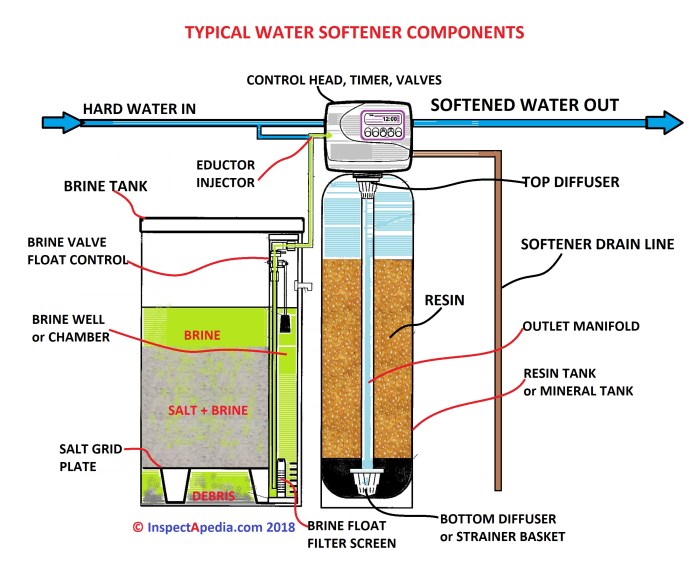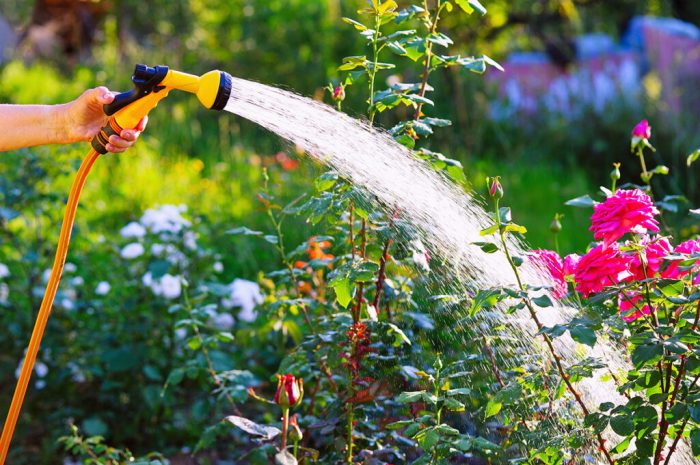Is Water Softener Bad for Plants?
Salt Content and Plant Health
Is water softener bad for plants – High salt concentrations in water can significantly impact plant health, affecting their ability to absorb water and nutrients. This section will explore the effects of salinity on plant cells, water uptake mechanisms, and the varying salt tolerance levels across different plant species.
Effects of High Salt Concentrations on Plant Cells
High salt concentrations create a hypertonic environment around plant roots, causing water to move out of the plant cells via osmosis. This leads to cellular dehydration, wilting, and ultimately, plant death. The disruption of cellular turgor pressure also affects cell expansion and growth. Furthermore, high salt levels can interfere with essential cellular processes and damage cellular structures.
Mechanisms of Salt-Affected Water Uptake
Salt ions compete with essential nutrients like potassium and calcium for absorption sites in plant roots. This reduces the uptake of crucial nutrients, leading to nutrient deficiencies and stunted growth. The high osmotic pressure caused by salt also reduces the water potential gradient between the soil and the plant roots, making it more difficult for plants to absorb water.
Salt Tolerance of Different Plant Species
Plants exhibit varying degrees of salt tolerance. Halophytes, such as mangroves and salt marsh grasses, are adapted to thrive in high-salt environments. They possess mechanisms to regulate salt uptake and accumulation, often storing excess salt in specialized tissues. Conversely, glycophytes, including most garden plants and agricultural crops, are sensitive to high salinity and suffer significant damage under saline conditions.
Examples of Salt-Sensitive Plants
Many common garden plants are highly sensitive to salt. Examples include tomatoes, peppers, lettuce, and beans. These plants often exhibit symptoms of salt stress even with moderately elevated salt levels in their watering solution. Their growth is significantly stunted, and their leaves may show signs of burning or discoloration.
Comparison of Salt Content in Water Sources
| Water Source | Total Dissolved Solids (TDS) (mg/L) | Sodium (Na) (mg/L) | Chloride (Cl) (mg/L) |
|---|---|---|---|
| Rainwater | <50 | <1 | <1 |
| Hard Water | 150-300+ | Variable, often low | Variable, often low |
| Softened Water | Variable, often lower than hard water but higher in sodium | High (due to sodium ion exchange) | Lower than hard water |
Note
These are approximate values and can vary greatly depending on location and specific water source.*
Sodium and Plant Growth: Is Water Softener Bad For Plants
While sodium (Na) is not an essential nutrient for most plants, it can play a complex role in plant growth. This section will examine the role of sodium, its interaction with other nutrients, and its potential toxicity in plants.
Role of Sodium in Plant Nutrition
Some plants, particularly halophytes, can utilize sodium to a limited extent as a substitute for potassium (K) in certain metabolic processes. However, for most plants, excessive sodium can be detrimental, hindering growth and development. Sodium can also affect the plant’s ability to regulate water balance and nutrient uptake.
Sodium Uptake vs. Potassium Uptake

Source: inspectapedia.com
Plants absorb sodium and potassium through similar mechanisms. However, the plant’s preference is for potassium, which is essential for numerous enzymatic reactions and maintaining turgor pressure. Excessive sodium can inhibit potassium uptake, leading to potassium deficiency.
Symptoms of Sodium Toxicity in Plants
Sodium toxicity can manifest in various symptoms, including leaf burn, wilting, stunted growth, and chlorosis (yellowing of leaves). The severity of symptoms depends on the plant species, the level of sodium exposure, and other environmental factors.
Effects of Sodium on Plant Enzyme Activity
High levels of sodium can interfere with the activity of various plant enzymes, disrupting essential metabolic processes such as photosynthesis and respiration. This further contributes to stunted growth and reduced yield. Sodium can also alter the structure and function of cell membranes.
Experiment Comparing Plant Growth with Softened and Unsoftened Water
To compare the effects of softened and unsoftened water on plant growth, a controlled experiment could be designed. Identical plant seedlings (e.g., lettuce) would be grown in separate pots containing the same soil type and watered with either softened or unsoftened water for a set period (e.g., 4 weeks). Growth parameters like height, leaf area, and biomass would be measured and compared between the two groups.
Statistical analysis would determine if there are significant differences in growth.
Water Softener Types and Their Impact
Different water softener types utilize distinct chemical processes to remove minerals, resulting in varying impacts on plant health. This section will compare ion exchange and reverse osmosis softeners, analyzing their effects and byproducts.
Comparison of Ion Exchange and Reverse Osmosis Softeners, Is water softener bad for plants
Ion exchange softeners replace calcium and magnesium ions with sodium ions, reducing water hardness but increasing sodium concentration. Reverse osmosis systems physically filter out minerals and impurities, including sodium, resulting in a lower mineral content overall.
While softened water’s high sodium content can be detrimental to some plants, the question often arises about alternative water sources. Considering this, you might wonder if using water from a fish tank is a viable option, as explored in this article: is fish aquarium water good for plants. Ultimately, the best approach for plant watering depends on the specific plant’s needs and the water’s mineral composition, making both softened water and aquarium water potentially problematic depending on the circumstances.
Chemical Processes Involved
Ion exchange involves passing water through a resin bed containing sodium ions. These ions exchange places with the hardness minerals (calcium and magnesium), softening the water. Reverse osmosis uses pressure to force water through a semi-permeable membrane, separating water from dissolved salts and minerals.
Effects of Water Softener Byproducts
The primary byproduct of ion exchange softening is the increased sodium concentration in the water. Reverse osmosis produces a concentrated stream of waste brine containing the removed minerals and impurities. This brine should be disposed of properly to avoid environmental contamination.
Effects of Water Softener Regeneration

Source: waterdepot.com
Regeneration of ion exchange softeners involves flushing the resin bed with a concentrated salt solution to replenish the sodium ions. This process can introduce high levels of salt into the wastewater, potentially impacting the surrounding environment if not managed carefully.
Water Softener Types and Their Effects on Plants
- Ion Exchange: Increases sodium levels in water, potentially leading to sodium toxicity in sensitive plants.
- Reverse Osmosis: Reduces overall mineral content, potentially leading to nutrient deficiencies if not supplemented.
Practical Implications for Gardening
Using softened water for irrigation requires careful consideration. This section provides best practices for watering plants with softened water, focusing on adjusting watering schedules and choosing appropriate plant species.
Best Practices for Watering with Softened Water
Water plants deeply but less frequently to encourage deep root growth, reducing the impact of high sodium concentration near the surface. Consider diluting softened water with rainwater or unsoftened water to reduce salinity. Monitor plants closely for signs of sodium toxicity.
Adjusting Watering Schedules
Softened water may lead to increased evaporation from the soil surface due to its higher sodium concentration. Therefore, you may need to adjust watering schedules, potentially watering less frequently but more deeply. Observe soil moisture levels to guide watering decisions.
Plants that Thrive with Softened Water
Some plants exhibit higher tolerance to sodium and may thrive even with softened water. These include salt-tolerant species and plants with efficient sodium exclusion mechanisms. However, it’s always advisable to monitor plant health closely.
Importance of Soil Type and Drainage
Well-draining soil is crucial when using softened water. Good drainage prevents the accumulation of excess sodium in the root zone, minimizing the risk of salt buildup. Sandy soils generally drain better than clay soils.
Impact of Different Water Types on Plant Root Systems
Imagine three root systems. The root system watered with rainwater is robust and extensive. The root system watered with hard water is somewhat less extensive. The root system watered with softened water shows signs of stunted growth, with shorter, thicker roots and potential signs of root burn near the surface.
Alternative Watering Methods
Several alternatives minimize the negative impacts of softened water on plants. This section explores rainwater harvesting, water filtration, and soil amendment techniques.
Alternative Watering Methods to Minimize Negative Effects
Using alternative watering methods can mitigate the negative effects of softened water. Rainwater harvesting is an excellent option, providing naturally soft water free from added salts.
Benefits of Rainwater Harvesting
Rainwater harvesting provides a free and environmentally friendly source of irrigation water. It’s naturally soft and low in salts, ideal for most plants. Collecting rainwater reduces reliance on municipal water supplies and conserves resources.
Using Water Filters to Improve Water Quality
Water filters can remove excess salts and minerals from softened water. Reverse osmosis filters are particularly effective in removing sodium ions. However, ensure that the filtered water contains sufficient essential nutrients for plant growth.
Amending Soil to Improve Salt Handling

Source: delmarvawatersolutions.com
Adding organic matter, such as compost or well-rotted manure, to the soil can improve its ability to buffer against excess salts. Organic matter increases soil water holding capacity and enhances drainage, reducing salt accumulation in the root zone.
Creating a Simple Soil Test to Assess Salt Levels
A simple soil test can help assess salt levels. Collect a soil sample and mix it with distilled water. Measure the electrical conductivity (EC) of the solution using an EC meter. Higher EC values indicate higher salt levels.
FAQ Insights
Can I use softened water on all plants?
No. Some plants are more sensitive to salt than others. Always research the specific needs of your plants.
How can I test my water for salt content?
Home soil testing kits can measure salt levels. Professional labs offer more precise analysis.
What are the signs of sodium toxicity in plants?
Symptoms include leaf burn, wilting, stunted growth, and yellowing leaves.
Is reverse osmosis water better for plants than ion exchange softened water?
Generally, reverse osmosis water is better as it removes more minerals, including sodium, but it can also remove beneficial minerals. The best choice depends on your specific situation and plant needs.




















